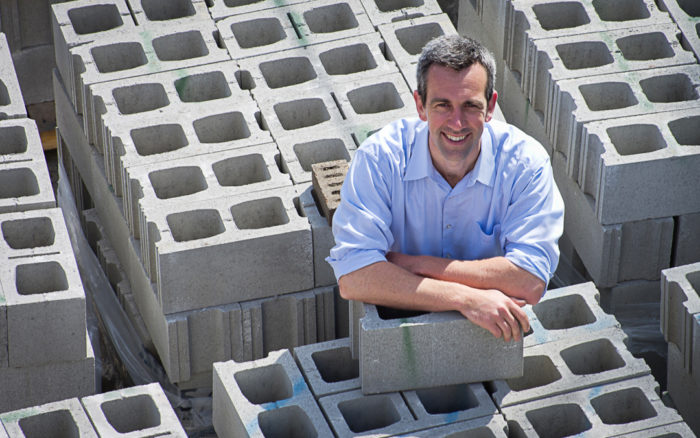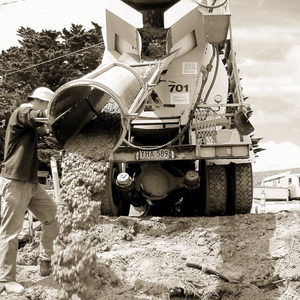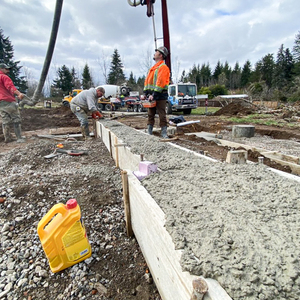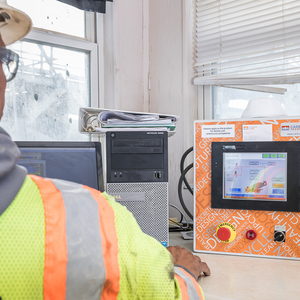
Concrete’s exceptional strength and durability have helped make it the most abundant man-made material on the planet. But the portland cement that binds concrete’s ingredients together is made in high-temperature kilns, which are a major source of the carbon dioxide that contributes to global climate change.
That’s a disturbing reality for the industry. But a $20 million competition called the NRG/COSIA Carbon XPrize is highlighting new technologies that reduce or even eliminate the need for cement in concrete and precast products, making the material more attractive to green builders by lowering its environmental impact.
XPrizes were created in 1994, and to date there have been 17 of them in fields that include space, oceans, learning, health, and the environment. The ongoing carbon competition is now down to 10 finalists that are in the process of demonstrating the viability of their technologies at test facilities in Wyoming and Alberta, Canada.
Each of the finalists, which were announced earlier this year, got $500,000 to continue their work. The two winners that will be announced in 2020 each will walk away with $7.5 million.
The finalists are working on a variety of technologies aimed at making carbon useful, if not simply less harmful. Three of them are focused specifically on the concrete problem. The stakes are huge: The U.S. used more than 122 million metric tons of portland cement in 2006, according to an article in Scientific American, while China used at least 800 million metric tons. Producing cement accounts for an estimated 7% of greenhouse gas emissions globally.
CarbonCure is already up and running
One of the XPrize finalists is CarbonCure, a privately held Canadian firm founded in 2007. It developed the technology to inject liquid carbon dioxide into concrete as it’s being mixed. The technique can be used on ready-mix and in the manufacture of concrete block.
Christie Gamble, CarbonCure’s director of sustainability, said the technique does not require any changes in the way concrete producers work, and it allows ready-mix firms to reduce the amount of portland cement they use.
“Operationally, it is very simple,” she said. “It’s essentially the same as injecting an admixture into the mix except in this case the admixture is C02 that originally came from an emitter source.”
The carbon dioxide comes from large industrial plants, where it is gathered by an industrial gas supplier, purified, and then trucked to CarbonCure customers. Under pressure of 300 pounds per square inch, the gas is a liquid.
The carbon dioixde increases the 28-day compressive strength of concrete by about 10%, Gamble said. Ready-mix firms can reduce the amount of cement in the range of 5% to 7%, and sometimes more, and get concrete with the same compressive strength as a conventional mix. Because cement is the most expensive ingredient in concrete, she said, producers may be able to offset the cost of licensing fees that producers pay monthly to CarbonCure.
Block manufacturers don’t see the same cement-reducing benefits. The mix those producers use is already very “lean,” Gamble said, with less cement than ready-mix concrete. So far, block producers haven’t been able to cut back on their use of cement, but they still get the environmental and marketing benefits of carbon sequestration.
CarbonCure now has more than 100 concrete plants in Canada and the U.S. using its technology. (A map showing where they are located is posted at the company’s website.) A key to growth has been helping producers avoid disruptions as they adopt the new technology.
“We understood inherently that if we wanted to be able to promote carbon reduction, it has to be a technology that made financial sense, made operational sense, that didn’t affect schedules or basically the way in which concrete was made,” she said. “We understood it needed to be as easy and simple and sensible as possible in order to help the industry transition into lower carbon.”
Producers pay no upfront costs to use the equipment and software that goes with it. They pay for the carbon dioxide they use plus a licensing fee. Gamble wouldn’t talk specifics about the cost to producers, but she said the goal is to make the process cost-neutral or even cost-positive by allowing concrete plants to trim their consumption of cement.
Carbicrete eliminates cement altogether
Another Canadian firm, Carbicrete, promotes its precast concrete products as 30% stronger than conventional concrete, cheaper, and completely cement-free. The trick is replacing cement with steel slag, a byproduct of steelmaking, and injecting the mix with carbon dioxide.
The company says its initial focus is the North American precast concrete market,, followed by China, “where more concrete was produced between 2012 and 2015 than was produced in the United States in all of the 20th century.”
The Montreal-based company has a patent pending on the process and intends to license it to producers. It would supply them with steel slag. The process, which is being tested at the Alberta center, is in the “lab pilot” stage and the company is currently in talks with several concrete makers, an industrial gas supplier, and a steel slag handler.
In a prepared statement earlier this year, Carbicrete CEO Chris Stern said, “It’s carbon-negative. What’s more, because steel slag is effectively waste, our material costs are significantly lower, allowing us to offer the construction industry a more cost-effective product with even better strength and durability properties than conventional concrete.”
This mix uses fly ash
Carbon Upcycling UCLA, also on the XPrize finalists list, is a startup led by Dr. Gaurav Sant, an associate professor of civil and environmental engineering at the University of California Los Angeles. The company calls its product CO2NCRETE and says its technology creates prefabricated components with half the carbon footprint of conventional concrete. The firm’s target is the precast concrete and concrete masonry markets.
Carbon Upcycling explains that the process is designed to use flue gas exhausted from emitters such as power plants and cement plants. A calcium hydroxide binder is mixed with aggregates and admixtures, and then combined with captured C02 to form building components that can be used to make bridges, buildings, and other structures, according to the startup’s website.
The mix also can include fly ash, which it says is both abundant and cheap. Carbon Upcycling touts the low cost of the concrete, minimal capital investment, and few required modifications to existing production equipment.
Carbon Upcycling is being evaluated at the Wyoming test center. The company says that it intends to license the technology to users who in turn could use it to win carbon credits and meet government and social pressure to reduce carbon emissions.
Commercialization of the process is still 5 to 7 years off, and UCLA is currently looking for financial support for the project.
A hit with customers
Adopting new technology to reduce carbon emissions can be a leg up on the marketing side as concerns over climate change deepen. A. Jandris & Sons, a block manufacturer in Gardner, Massachusetts, has been using the CarbonCure system for a couple of years and found that it fits neatly into efforts to lower the environmental impact of its products, says Heidi Jandris, who among other things manages technical services for the family-owned firm.
“It’s one of the many things we’ve been doing to try to lower our environmental impact,” she said by phone. “We have environmental product declarations for every single one of our mixes so we can compare what we’re doing as far as raw material choices and lowering our impact. It’s part of our sustainability package.”
Jandris became interested in sustainable design while studying architecture. When she graduated, she returned to the family firm and brought with her an interest in making products with a lower environmental impact.
Because block manufacturers still need to use the same amount of cement, however, Jandris & Sons is missing out on the cost advantages that ready-mix plants might see. How is that affecting the price of its block? Jandris wasn’t specific, saying only, “We’re still trying to figure out how to navigate that.”
The block has been popular with customers, particularly architects, she said, adding, “They’ve been really supportive.”
Jandris added that while the concrete industry should continue work on reducing its carbon emissions, the debate sometimes overlooks the benefits of the material.
“Cement is the initial thing we need to work on as an industry,” she said, “but I think we don’t talk enough about the durability of concrete. Sometimes we don’t get a fair shake. I know making cement is our biggest problem, but there’s a lot of benefits to concrete as well. Durability and resilience are the big ones that pop into my mind.”
Building codes and concrete
Gamble said the company hasn’t run into problems to date with getting C02 enriched concrete accepted by building officials. Carbon sequestration is written into the Canadian building standards and the company is currently working with ASTM to get the process officially recognized.
Because C02 is converted into calcium carbonate, which is already an accepted material in concrete, the company hasn’t had trouble with existing codes and standards, she said.
One potential problem area, however, are big commercial jobs where material specifications may require a minimum cement content in the concrete. That could prevent concrete producers from reducing the amount of cement they use, even if it’s not required from a strength perspective. Planning ahead and getting approval for the mix in advance has, at least so far, headed off problems.
“The important thing at the end of the day is what we’re able to deliver to developers,” Gamble said. “The concrete they’re receiving at the construction site is the same concrete they would otherwise receive. There’s no impact on the properties or the quality of the concrete itself. It’s just greener.”
Weekly Newsletter
Get building science and energy efficiency advice, plus special offers, in your inbox.















4 Comments
Thanks Scott. Interesting stuff!
> Under pressure of 300 pounds per square inch, the gas is a liquid.
At 0F - ~1000 psi at more typical temperatures.
Carbon sequestration is mostly about cost/ton and should be compared to other methods.
Would be interesting to see more about reducing concrete use - for example, block vs poured walls, using additional gravel base with thinner slabs and rubble trench foundations.
My concern is not only strength but longevity, 100 or 200 years from now will this concrete be as strong as regular concrete?
That comment about CO2 being liquid above a certain pressure is misleading. The critical point of CO2 is about 87.8 F, 1,070 psia. Above that temperature, there is no liquid state for CO2 at any pressure; all you have is high density, supercritical stuff. To have liquid at 300 psig, the temperature must be below zero (roughly), F. Presumably the liquid is delivered cold, per this reference: http://www.co2info.com/co2.html
Log in or create an account to post a comment.
Sign up Log in